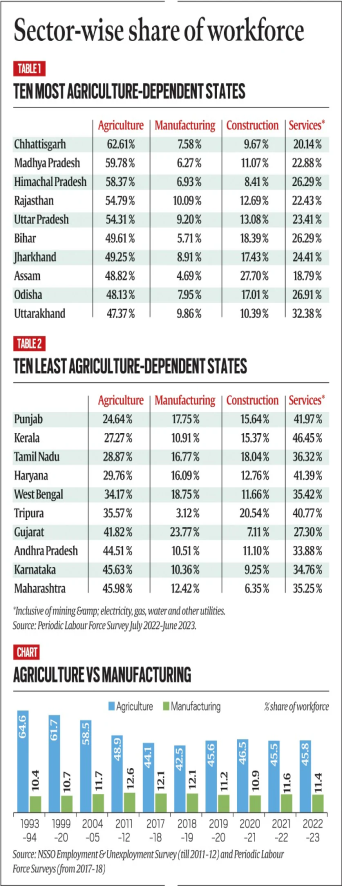Free Courses Sale ends Soon, Get It Now


Free Courses Sale ends Soon, Get It Now



Copyright infringement not intended
Picture Courtesy: www.iisd.org
Context: India should focus on transforming its agricultural sector through technology and value addition to create jobs and economic growth, rather than solely relying on traditional labour-intensive manufacturing.
Details
Key points from the Lewis Model
|
Surplus Labor in Agriculture |
●Lewis observed that in many underdeveloped countries, a significant portion of the population was engaged in low-productivity agriculture, where the marginal productivity of labour was negligible, zero, or even negative. This meant that withdrawing labour from agriculture would not lead to a reduction in agricultural output but, on the contrary, could potentially make the remaining holdings more productive through mechanization. |
|
Industrialization as a Solution |
●Lewis proposed that the solution to the surplus labour problem was the growth of the manufacturing (capitalist) sector. If factories could pay wages just slightly higher than subsistence wages, workers would have an incentive to leave agriculture and work in the manufacturing sector. This would create a self-sustaining process of industrialization. |
|
Inevitability of Industrialization |
●Lewis believed that industrialization was virtually inevitable for countries with surplus labour populations. He specifically mentioned India as an example. As long as the subsistence wage levels in manufacturing matched the value of the additional output produced, factories would continue to hire more workers. |
|
Bottlenecks |
●The main bottlenecks to this transition from agriculture to manufacturing were identified as the availability of capital and natural resources. Many underdeveloped countries lacked the capital needed to establish and expand manufacturing industries, and they also faced constraints related to natural resources. |
Application of the Lewis model in India
Shift from Agriculture
Manufacturing Growth
Service Sector Dominance
State-Level Variations
Changing Economic Landscape
New Economic Development Models

The model has worked differently in India compared to China for several reasons:
|
Differences in Industrialization |
●In China, the Lewis Model was more successful because it leveraged its demographic dividend and surplus rural labour to become the "world's factory." ●China rapidly industrialized by attracting labour-intensive industries and export-oriented manufacturing. In contrast, India's industrialization process has been slower and less labour-intensive. Manufacturing in India didn't grow at the same pace as in China. |
|
Capital-Intensive Manufacturing |
●Manufacturing in both India and China has been shifting towards capital-intensive methods, such as automation and technology adoption. This shift has reduced the labour intensity of the manufacturing sector, making it less effective in absorbing surplus agricultural labour. |
|
Economic Structure |
●India's economic structure is diverse, with a significant emphasis on the services sector, which has absorbed a considerable portion of the labour force that moved away from agriculture. In contrast, China's economic structure was more manufacturing-oriented during its rapid industrialization phase. |
|
Challenges in the Manufacturing Sector |
●India faces challenges in its manufacturing sector, such as inadequate infrastructure, complex regulations, and labour market rigidities, which have hindered the growth of labour-intensive manufacturing. |
|
State-Level Disparities |
●State-level disparities in India play a crucial role. States like Gujarat have been more successful in attracting manufacturing due to their business-friendly policies, while other states have been less successful in replicating the Lewis Model. |
|
Changing Dynamics |
●The global economic landscape and the nature of manufacturing are evolving. Labor-intensive industries are being replaced by technology-intensive and capital-intensive sectors. India needs to adapt to these changes and find new models for economic development. |
Conclusion
|
PRACTICE QUESTION Q. How can the Indian government and private sector work together to promote and facilitate the generation of more jobs in the agriculture sector to address unemployment and promote rural development? |
© 2024 iasgyan. All right reserved